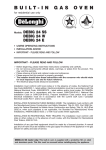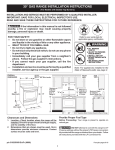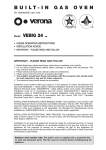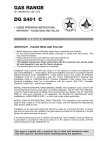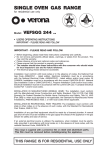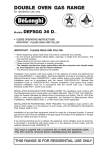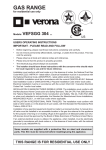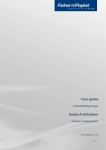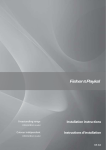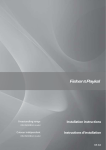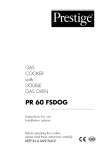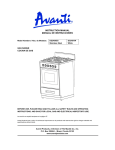Download De'Longhi DEBIGE 2440 E User's Manual
Transcript
BUILT-IN DUAL FUEL DOUBLE OVEN for residential use only Models: DEBIGE 2440 SS DEBIGE 2440 E DEBIGE 2440 W • USERS OPERATING INSTRUCTIONS • INSTALLATION ADVICE • IMPORTANT - PLEASE READ AND FOLLOW IMPORTANT - PLEASE READ AND FOLLOW ✓ Before beginning, please read these instructions completely and carefully. ✓ Do not remove permanently affixed labels, warnings, or plates from the product. This may void the warranty. ✓ Please observe all local and national codes and ordinances. ✓ Please ensure that this product is properly grounded. ✓ The installer should leave these instructions with the consumer who should retain for local inspector's use and for future reference. ✓ The electrical plug should always be accessible. Installation must conform with local codes or in the absence of codes, the National Fuel Gas Code ANSIZ223.1 - Iatest edition. Electrical installation must be in accordance with the National Electrical Code, ANSI/NFPA70 - latest edition and/or local codes. IN CANADA: Installation must be in accordance with the current CAN/CGA-B149.1 National Gas Installation Code or CAN/CGA-B149.2, Propane Installation Code and/or local codes. Electrical installation must be in accordance with the current CSA C22.1 Canadian Electrical Codes Part 1 and/or local codes. INSTALLATION IN MANUFACTURED (MOBILE) HOME: The installation must conform with the Manufactured Home Construction and Safety Standard, Title 24 CFR, Part 3280 [formerly the Federal Standard for Mobile Home Construction and Safety, Title 24, HUD (Part 280)] or, when such standard is not applicable, the Standard for Manufactured Home Installations, ANSI/NCSBCS A225.1, or with local codes where applicable. INSTALLATION IN RECREATIONAL PARK TRAILERS: The installation must conform with state or other codes or, in the absence of such codes, with the Standard for Recreational Park Trailers, ANSI A119.5. Installation of any gas-fired equipment should be made by a Iicensed plumber. A manual gas shut-off valve must be installed in the gas supply line ahead of the appliance in the gas stream for safety and ease of service. DEBIGE 2440 SS model only: This built-in double oven is supplied with a protective film on steel and aluminium parts. This film must be removed before installing/using the appliance. WARNING: IF THE INFORMATION IN THIS MANUAL IS NOT FOLLOWED EXACTLY, A FIRE OR EXPLOSION MAY RESULT CAUSING PROPERTY DAMAGE, PERSONAL INJURY, OR DEATH. ✓ Do not store or use gasoline or other flammable vapors and liquids in the vicinity of this or any other appliance. ✓ WHAT TO DO IF YOU SMELL GAS: • Do not try to light any appliance. • Do not touch any electrical switch; do not use any phone in your building. • Immediately call your gas supplier from a neighbor's phone. Follow the gas supplier's instructions. • If you cannot reach your gas supplier, call the fire department. ✓ Installation and service must be performed by a qualified installer, service agency, or the gas supplier. WARNING NEVER use this appliance as a space heater to heat or warm the room. Doing so may result in carbon monoxide poisoning and overheating of the oven. This appliance is designed and manufactured solely for the cooking of domestic (household) food and is not suitable for any none domestic application and therefore should not be used in a commercial environment. The appliance guarantee will be void if the appliance is used within a none domestic environment i.e. a semi commercial, commercial or communal environment. 2 Dear Customer, Thank you for having purchased and given your preference to our product. The safety precautions and recommendations reported below are for your own safety and that of others. They will also provide a means by which to make full use of the features offered by your appliance. Please preserve this booklet carefully. It may be useful in future, either to yourself or to others in the event that doubts should arise relating to its operation. This appliance must be used only for the task it has explicitly been designed for, that is for cooking foodstuffs. Any other form of usage is to be considered as inappropriate and therefore dangerous. The manufacturer declines all responsibility in the event of damage caused by improper, incorrect or illogical use of the appliance. DATA PLATE CONVERSION LABEL 3 USER INSTRUCTIONS IMPORTANT PRECAUTIONS AND RECOMMENDATIONS After having unpacked the appliance, check to ensure that it is not damaged. In case of doubt, do not use it and consult your supplier or a professionally qualified technician. Packing elements (i.e. plastic bags, polystyrene foam, nails, packing straps, etc.) should not be left around within easy reach of children, as these may cause serious injuries. The packaging material is recyclable and is marked with the recycling symbol . ✓ Do not attempt to modify the technical characteristics of the appliance as this may become dangerous to use. ✓ Do not carry out cleaning or maintenance operations on the appliance without having previously disconnected it from the electric power supply. ✓ After use, ensure that the knobs are in OFF position. ✓ Do not allow children or other incapable people to use the appliance without supervision. ✓ During and after use of the oven, certain parts will become very hot. Do not touch hot parts. ✓ Keep children away from the oven when it is in use. ✓ For DEBIGE 2440 SS model only: This double oven is supplied with a protective film on steel and aluminium parts. This film must be removed before installing/using the appliance. ✓ Fire risk! Do not store flammable material in the ovens. ✓ Make sure that electrical cables connecting other appliances in the proximity of the oven cannot become entrapped in the oven doors. ✓ Do not line the oven walls with aluminium foil. Do not place shelves, broiler pan, pans or other cooking utensils on the base of the oven chamber. ✓ The manufacturer declines all liability for injury to persons or damage to property caused by incorrect or improper use of the appliance. ✓ To avoid any possible hazard, the appliance must be installed by qualified personnel only. Any repairs by unqualified persons may result in electric shock or short circuit. In order to avoid possible injuries to your body or to the appliance, do not attempt any repairs by yourself. Such work should be carried out by qualified service personnel only. KEEP ATTENTION!! STAND AWAY FROM THE CONTROL PANEL LOUVERS (see figure above). HOT AIR WHICH ESCAPES CAN CAUSE BURNS TO HANDS, FACE, END/OR EYES. 4 ✓ Important! The use of suitable protective clothing/gloves is recommended when handling, installing or cleaning of this appliance. ✓ Danger of burns! The double oven and cooking accessories may become very hot during operation. Make sure children are kept out of reach and warn them accordingly. To avoid burns use kitchen clothes and gloves when handling hot parts or utensils. ✓ Stand away from the oven when opening oven door. Hot air or steam which escapes can cause burns to hands, face, and/or eyes. ✓ Never clean the double oven with a high-pressure steam cleaning device, as it may provoke a short circuit. ✓ This appliance is intended for use in your household. Never use the appliance for any other purpose! ✓ If you should decide not to use this appliance any longer (or decide to substitute an older model), before disposing of it, it is recommended that it be made inoperative in an appropriate manner in accordance to health and environmental protection regulations, ensuring in particular that all potentially hazardous parts be made harmless, especially in relation to children who could play with old appliances. Remove the door before disposal to prevent entrapment. ✓ WARNING!! This appliance shall not be used for space heating. This information is based on safety considerations. ✓ Keep appliance area clear and free from combustible materials, gasoline, and other flammable vapors. ✓ The misuse of oven doors (e.g. stepping, sitting, or leaning on them) can result in potential hazards and/or injuries. IMPORTANT PRECAUTIONS AND RECOMMENDATIONS FOR USE OF ELECTRICAL APPLIANCES Use of any electrical appliance implies the necessity to follow a series of fundamental rules. In particular: ✓ Never touch the appliance with wet hands or feet; ✓ Do not operate the appliance barefooted; ✓ Do not allow children or disabled people to use the appliance without your supervision. The manufacturer cannot be held responsible for any damages caused by improper, incorrect or unreasonable use of the appliance. 5 control panels Fig. 1.1 3 1 4 2 Fig. 1.2 7 CAUTION: Gas appliances produce heat and humidity in the environment in which they are installed. Ensure that the cooking area is well ventilated following national/local codes. 6 CONTROL PANELS (Fig. 1.1 - 1.2) 1. 2. 3. 4. 5. 6. 7. Gas oven thermostat knob (Lower gas oven) Gas oven light control knob (Lower gas oven) Cooling fan failure warning light (Lower gas oven) Electric oven function selector knob (Upper electric oven) Electric oven temperature selector knob (Upper electric oven) Electric oven temperature light (Upper electric oven) Electronic clock/electronic alarm 5 6 WARNING VERY IMPORTANT NOTICE When the cooling fan failure warning light is OFF the cooling fan motor is correctly operating. Both the ovens can be used. Operate the ovens as per instruction manual. When the cooling fan failure warning light is lighted this indicates the malfunctioning of the cooling fan motor. 1. Close the supply line manual shut-off valve. Disconnect the oven from the gas mains and contact the After-Sales Service. Shut-off valve "close" position The lower gas oven cannot be used. Only the upper electric oven can be used. 2. Contact the After-Sales Service. SERVICE 7 electronic clock/end cooking timer ELECTRONIC CLOCK (fig. 2.1) The electronic alarm is a device which groups the functions of 12 hours clock with illuminated display and 10 hours alarm. Upon immediate connection of the oven or after a blackout, 12•00 will flash on the display. To set the hour it is necessary to push the button and then, within 7 seconds, the or button until you have set the exact hour. An energy black-out makes the clock go to zero. SET TIME OF DAY Push button and then, within 7 seconds, the or button until you have set the exact hour. This function remains activated 7 seconds after the last pushing of or button. Change the hours only: press the button for 4 seconds until the hours display will flash. Change the hours only by pushing the or button. The minutes and hidden seconds will not be affected. ELECTRONIC ALARM Fig. 2.1 The alarm program consists only of a buzzer which may be set for a maximum period of 10 hours. To set the time, push the or button until you obtain the desired time in the display. From 0•10 to 99•50 you read the time in minutes and seconds (10 seconds step); then from 1•40 to 10•00 you read the time in hours and minutes (minutes step). Having finished the setting, the symbol will be lighted and the countdown will start immediately. During countdown the timer has priority in the display. To show the time of day press button. At the end of the time, the symbol will be switched off and an intermittent buzzer, during 7 minutes, will go off; this can be stopped by pressing the button. The signal will be skipped if button is pressed during the last 15 seconds of the timer. To stop the alarm countdown in any moment keep the 0•00 on the display (symbol switches off). button pressed until you read IMPORTANT WARNING: THIS IS ONLY AN ELECTRONIC ALARM. REMEMBER TO TURN OFF THE OVEN OR BROIL (LOWER AND/OR UPPER OVEN) MANUALLY AT THE END OF COUNTDOWN. SETTING THE FREQUENCY OF THE ALARM SOUND The selection from 3 possibilities of sound can be made by pressing the 8 button. how to use the lower gas oven GENERAL FEATURES The gas oven is provided with two burners: a) Oven burner, mounted on the lower part of the oven (11000 BTU/hr) b) Broil burner, mounted on the upper part of the oven (7000 BTU/hr). USING THE OVEN FOR THE FIRST TIME It is advised to follow these instructions: – Furnish the interior of the oven by placing the wire racks as described at chapter “Cleaning and maintenance”. – Insert shelves and tray. – Turn the oven on to the maximum temperature (position ) to eliminate possible traces of grease from the oven burner. The same operation should be followed for broil burner. – Switch off the electrical supply, let the oven cool down, then clean the interior of the oven with cloth soaked in water and detergent (neutral) then dry carefully. ATTENTION: the oven becomes very hot during operation. ATTENTION: the oven door becomes very hot during operation. KEEP CHILDREN AWAY. WARNING: The door is hot, use the handle. VERY IMPORTANT The oven/broil shall be used always with the oven door closed. OVEN BURNER It carries out normal “oven cooking”. The gas flow to the burner is regulated by a thermostat which allow to maintain the oven temperature constant. The control of the temperature is assured by a thermostatic probe positioned inside the oven. The probe must be always kept in its housing, in a clean condition, as an incorrect position or encrustment may cause an alteration in the control of the temperature. Fig. 3.1 OVEN THERMOSTAT The numbers printed on the control panel (fig. 3.1) indicate the increasing oven temperature value (°F). To regulate the temperature, set the chosen number onto the knob indicator. The position serves only to turn on the broil burner. N.B. When the oven is not being used, set the gas knob to the position and also close the gas shut-off valve placed on the main gas supply line. GAS OVEN SETTING Number printed on the control panel Temperature in °F Corresponding temperature in °C 200 93 250 121 300 149 350 177 400 204 450 232 500 260 550 288 9 IGNITION OF THE OVEN BURNER The thermostat allows the automatic control of the temperature. The gas delivery to the oven burner is controlled by a two way thermostatic tap (oven and broil burners) with flame-failure device. To light the oven burner operate as follows: 1) Open the oven door to its full extent. WARNING: Risk of explosion! The oven door must be open during this operation. 2) Lightly press and turn the thermostat knob anti-clockwise (fig. 3.2) to max position . Fig. 3.2 3) Press the knob right down to prime the electric ignition. Keep the knob pressed. In case of power cut, press the knob and immediately approach a lighted match to the opening “A” (fig. 3.3). Never continue this operation for more than 15 seconds. If the burner has still not ignited, wait for about 1 minute prior to repeating the ignition. 4) Wait about 10/15 seconds after the burner lighting before releasing the knob (time of priming of the valve). 5) Close the oven door slowly and adjust the burner according to the power required. If the flame extinguishes for any reason, the safety valve will automatically shut off the gas supply to the burner. To re-light the burner, first turn the oven control knob to position, wait for at least 1 minute and then repeat the lighting procedure. A Fig. 3.3 Attention: the oven door becomes very hot during operation. Keep children away. OVEN COOKING Before introducing the food, preheat the oven to the desired temperature. For a correct preheating operation, it is advisable to remove the tray from the oven and introduce it together with the food, when the oven has reached the desired temperature. Check the cooking time and turn off the oven 5 minutes before the theoretical time to recuperate the stored heat. 10 IGNITION OF THE BROIL BURNER The broil burner generates the infra-red rays for broiling. To light the broil burner operate as follow: 1) Open the oven door to the full extent. WARNING: Risk of explosion! The oven door must be open during this operation. position 2) Lightly press and turn the thermostat knob clockwise to the (fig. 3.4). 3) Press the knob right down to prime the electric ignition. Keep the knob pressed. In case of power cut, press the knob and put a lighted match to the right and left side of the burner (fig. 3.5). Never continue this operation for more than 15 seconds. If the burner has still not ignited, wait for about 1 minute prior to repeating the ignition. 4) Wait about 10/15 seconds after the burner lighting before releasing the knob (time of priming of the valve). Fig. 3.4 5) Close the oven door slowly. If the flame extinguishes for any reason, the safety valve will automatically shut off the gas supply to the burner. To re-light the burner, first turn the oven control knob to position, wait for at least 1 minute and then repeat the lighting procedure. Do always broil with oven door closed. Attention: the oven door becomes very hot during operation. Keep children away. Fig. 3.5 OVEN LIGHT The oven is equipped with a light that illuminates the oven to enable visually controlling the food that is cooking. This light is controlled by a switch knob (Fig. 3.6). To light the oven lamp turn the knob clockwise to position. Fig. 3.6 11 1° STEP Do not use 2° STEP Broiling level 3° STEP Oven cooking level 4° STEP Oven cooking level Fig. 3.7 BROILING Very important: the broil burner must always be used with the oven door closed. – Position the shelf on the second level from the top (fig. 3.7). – Turn on the broil burner, as explained in the preceding paragraphs and let the oven preheat for about 5 minutes with the door closed. – Place the food to be cooked above the broiler pan. – Introduce the broiler pan (fig. 3.8) in the oven. The broiler pan should be placed above the shelf and it should be centered with the broil burner (fig. 3.7). Do not broil without using the broiling pan. Fig. 3.8 Important: Use always suitable protective gloves when inserting/removing the broiling pan, shelves, pans or other cooking utensils from the oven. WRONG Fig. 3.9 CORRECT Fig. 3.10 12 how to use the upper electric oven GENERAL FEATURES As its name indicates, this is an oven that presents particular features from an operational point of view. In fact, it is possible to insert 4 different programs to satisfy every cooking need. The 4 positions, thermostatically controlled, are obtained by 3 heating elements which are: - Lower element 1000 W - Upper element 650 W - Broil element 1650 W USING THE OVEN FOR THE FIRST TIME It is advised to follow these instructions: - Furnish the interior of the oven by placing the wire rack as described at chapter “Cleaning and maintenance”. - Insert shelves and tray. - Operate the oven at the maximum temperature (temperature selector knob on position and function selector knob on position ) to eliminate possible traces of grease from the lower and upper heating elements. The same operation should be followed for the broil heating element (temperature selector knob on position and function selector knob on position ). - Switch off the electrical supply, let the oven cool down, then clean the interior of the oven with soaked in water and detergent (neutral) then dry carefully. OPERATING PRINCIPLES Heating and cooking in the upper electric oven are obtained in the following ways: ATTENTION: the oven becomes very hot during operation. ATTENTION: the oven door becomes very hot during operation. KEEP CHILDREN AWAY. WARNING: The door is hot, use the handle. VERY IMPORTANT The oven/broil shall be used always with the oven door closed. a. by normal convection ( function selector knob setting) The heat is produced by the upper and lower heating elements. b. by semi-forced convection ( function selector knob setting) The heat produced by the upper and lower heating elements is distributed throughout the oven by the fan. c. by radiation ( function selector knob setting) The heat is radiated by the infra-red broil element. d. by radiation and ventilation ( function selector knob setting) The radiated heat from the infra-red broil element is distributed throughout the oven by the fan. e. by ventilation ( function selector knob setting; temperature selector knob on OFF position) The food is defrosted by using the fan only without heat. Fig. 4.1 TEMPERATURE SELECTOR KNOB (fig. 4.1) To turn on the heating elements of the oven, set function selector knob to the required position and the temperature selector knob to the desired temperature. To set the temperature, turn the temperature selector knob indicator mark to the required temperature. The elements will turn on or off automatically which is determined by the thermostat. The operation of the heating elements is signalled by a light placed on the control panel. TEMPERATURE SETTING TABLE Knob setting Temperature Temperature in °F in °C WARM 113 45 150 150 65 200 200 93 250 250 121 300 300 149 350 350 177 400 400 204 450 450 232 500 500 260 BROIL 520 271 13 FUNCTION SELECTOR KNOB (fig. 4.2) Rotate the knob clockwise to set the oven to one of the following functions: OVEN LIGHT By turning the function selector knob to this setting, the oven light will illuminate in the oven cavity (15W). The oven light will operate on all selected functions. TRADITIONAL CONVECTION COOKING Fig. 4.2 The upper and lower heating elements are switched on. The heat is diffused by natural convection and the temperature can be regulated between and position (see “TEMPERATURE SETTING TABLE”) with the temperature selector knob. It is necessary to preheat the oven before introducing the foods to be cooked. Recommended for: For foods which require the same cooking temperature both internally and externally, i. e. roasts, spare ribs, meringue, etc. DEFROSTING FROZEN FOOD With the temperature selector knob in the position only the oven fan is on. The defrosting is done by simple ventilation without heat. Recommended for: To rapidly defrost frozen foods; 2.2 lb (1 kg) requires about one hour. The defrosting times vary according to the quantity and type of foods to be defrosted. CONVECTION COOKING WITH VENTILATION The upper and lower heating elements and the fan turn on. The heat coming from the top and bottom is diffused by forced convection. The temperature can be regulated between and position (see “TEMPERATURE SETTING TABLE”) with the temperature selector knob. Recommended for: For foods of large volume and quantity which require the same internal and external degree of cooking; for ex: rolled roasts, turkey, legs, cakes, etc. VENTILATED BROILING The infra-red broil element and the fan are on. The heat is mainly diffused by radiation and the fan then distributes it throughout the oven. The temperature can be regulated between and position (see “TEMPERATURE SETTING TABLE”) with the temperature selector knob. We suggest to set the temperature selector knob on position. It is necessary to preheat the oven for about 5 minutes. For correct use see chapter “VENTILATED BROILING AND BROILING”. Always broil with the oven door closed. Attention: the oven door becomes very hot during operation. Keep children away. Recommended for: For broiling when a fast outside browning is necessary to keep the juices in, i. e. veal steak, steak, hamburger, etc. 14 BROILING The infra-red broil heating element is switched on. The heat is diffused by radiation. Use with the oven door closed and the temperature selector knob can be regulated between and position (see “TEMPERATURE SETTING TABLE”). We suggest to set the temperature selector knob on position. For correct use see chapter “VENTILATED BROILING AND BROILING”. Recommended for: Intense broiling action for cooking with the infra-red element, browning, crisping, “au gratin”, toasting, etc. Always broil with the oven door closed. Attention: the oven door becomes very hot during operation. Keep children away. COOKING ADVICE STERILIZATION Sterilization of foods to be conserved, in full and hermetically sealed jars, is done in the following way: a. Set the function selector knob to position b. Set the temperature selector knob to position and preheat the oven. c. Fill the broiler tray with hot water. d. Set the jars onto the broiler tray making sure they do not touch each other and the door and set the thermostat knob to position . When sterilization has begun, that is, when the contents of the jars start to bubble, turn off the oven and let cool. REGENERATION Set the function selector knob to position and the temperature selector knob to position . Bread becomes fragrant again if wet with a few drops of water and put into the oven for about 10 minutes. ROASTING To obtain classical roasting, it is necessary to remember: – that it is advisable to maintain a temperature between 350 and 400 °C. – that the cooking time depends on the quantity and the type of foods. COOKING DIFFERENT DISHES AT THE SAME TIME With the function selector in position the ventilated oven allows you to cook different types of food at the same time. Fish, cakes and meat can be cooked together without the smells and flavours mixing. The only precautions required are the following: – The cooking temperatures must be as close as possible with a maximum difference of 70° - 80°F between the different foods. – Different dishes must be placed in the oven at different times according to the cooking time required for each one. This type of cooking obviously provides a considerable saving on time and energy. 15 1st, 2nd, 3rd STEP Do not use 4th, 5th STEP Broiling level 6th, 7th, 8th STEP Oven cooking level Fig. 4.3 VENTILATED BROILING AND BROILING Very important: the broil or ventilated broil must always be used with the oven door closed. • Position the shelf on the fourth or fifth level from the top (fig. 4.3). • Set the function selector knob to: for broiling with infra-red rays and fan; the hot air completely envelops the food that is to be cooked. for traditional broiling with infra-red rays. • Set the temperature selector knob between and position and preheat for about 5 minutes with the door closed. We suggest to set the temperature selector knob on position. Fig. 4.4 • Place the food to be cooked above the broiler pan. • Introduce the broiler pan (fig. 4.4) in the oven. The broiler pan should be placed above the shelf and it should be centered with the broil element (fig. 4.3). WRONG Do not broil without using the broiling pan. Important: Use always suitable protective gloves when inserting/removing the broiling pan, shelves, pans or other cooking utensils from the oven. Fig. 4.5 CORRECT Fig. 4.6 16 cleaning and maintenance GENERAL RECOMANDATION ✓ Important: Before any operation of cleaning and maintenance disconnect the appliance from the electrical supply. ✓ It is advisable to clean when the appliance is cold and especially for cleaning the enamelled parts. WARNING VERY IMPORTANT Before any operation of maintenance disconnect the appliance from the electrical mains supply. ✓ Avoid leaving alkaline or acidic substances (lemon juice, vinegar, etc.) on the surfaces. ✓ Avoid using cleaning products with a chlorine or acidic base. The oven must always be cleaned after every use, using suitable products and keeping in mind that its operation for 30 minutes on the highest temperature eliminates most grime reducing it to ashes. ✓ The use of suitable protective clothing/gloves is recommended when handling, cleaning this appliance. Do not use a steam cleaner because the moisture can get into the appliance thus make it unsafe. ENAMELLED PARTS ✓ All the enamelled parts must be cleaned with a sponge and soapy water only or other non-abrasive products. Dry preferably with a chamois leather. STAINLESS STEEL, PAINTED AND ALUMINIUM PARTS AND SILK-SCREEN PRINTED SURFACES ✓ Clean using an appropriate product. Always dry thoroughly. IMPORTANT: these parts must be cleaned very carefully to avoid scratching and abrasion. You are advised to use a soft cloth and neutral soap. ONLY SOAP/WARM WATER MUST BE USED TO CLEAN THE STAINLESS STEEL SURFACES. INSIDE OF OVEN This must be cleaned regularly. Remove and refit the side runner frames as described on the next chapters. With the oven warm, wipe the inside walls with a cloth soaked in very hot soapy water or another suitable product. Lower panel (lower gas oven only), side runner frames and rack can be removed and washed in the sink. 17 UPPER ELECTRIC OVEN ACCESSORIES INSTALLATION AND REMOVAL – Hang up the wire racks “A” on the upper oven walls (fig. 5.1). – Slide in, on the guides, the shelf etc. (fig. 5.2). Do not use the first three steps from the top. The rack must be fitted so that the safety catch, which stops it sliding out, faces the inside of the oven. – Position the broiler pan above the oven shelf. – To dismantle, operate in reverse order. Do not use these 3 steps Safety catch 1 2 3 A Fig. 5.1 Fig. 5.2 LOWER GAS OVEN ACCESSORIES INSTALLATION AND REMOVAL – Hang up the wire racks “B” on the lower oven walls (fig. 5.3). – Slide in, on the guides, the shelf etc. (fig. 5.4). Do not use the first step from the top. The rack must be fitted so that the safety catch, which stops it sliding out, faces the inside of the oven. – Position the broiler pan above the oven shelf. – To dismantle, operate in reverse order. Do not use this step B Fig. 5.3 Safety catch Fig. 5.4 REPLACING THE OVEN LIGHT Before any maintenance is started involving electrical parts of the appliance, it must be disconnected from the power supply. – Let the oven cavity and the broil burner (lower oven) / upper + broil element (upper oven) cool down; – Switch off the electrical supply; – Remove the protective cover; – Unscrew and replace the bulb with a new one suitable for high temperatures (300°C570°F) having the following specifications: 120V 60 Hz, 15W, E14 – Refit the protective cover. NOTE: Oven bulb replacement is not covered by your guarantee. 18 OVEN DOORS The internal glass of the oven doors can be easily removed for cleaning by unscrewing the two fixing screws (figs. 5.5 - 5.6). Do not store flammable material in the ovens. Fig. 5.5 Fig. 5.6 REMOVING THE OVEN DOORS To facilitate oven cleaning, it is possible to remove the door. Please follow the instructions carefully: – Open the door completely. – Push down the lever “L” and, keeping it in this position, slowly close the door in order to block the hinge (fig. 5.7). – Grip the door (as indicated in fig. 5.8) and, while closing it, release the two hinges as shown in fig. 5.9. – Rest the door on a soft surface. L DOOR ASSEMBLY – Grip the door with your hands placed near the hinges and raise the levers “H” with your forefingers (fig. 5.9) – Insert the hinges in their position until levers “H” are hooked. – Open the door completely to obtain the release of levers “L”. Fig. 5.7 H Fig. 5.8 Fig. 5.9 19 DO’S AND DO NOT’S • Do always broil with the oven door closed. • Do read the user instructions carefully before using the oven for first time. • Do allow the oven to heat for one and a half hours, before using for the first time, in order to expel any smell from the new oven insulation, without the introduction of food. • Do clean your oven regularly. • Do remove spills as soon as they occur. • Do always use oven gloves when removing food shelves and trays from the oven. • Do not allow children near the oven when in use. • Do not allow fat or oils to build up in the oven base, or oven accessories. • Do not place cooking utensils or plates directly onto the oven base. • Do not broil without using the broiler pan. • Do not place hot enamel parts in water. Leave them to cool first. • Do not allow vinegar, coffee, milk, saltwater, lemon or tomato juice to remain in contact with enamel parts (i.e. inside the oven). • Do not use abrasive cleaners or powders that will scratch the surface of the stainless steel and the enamel. • Do not attempt to repair the internal workings of your oven. • DEBIGE 2440 model only: Do remove the protective film before the first use. • Fire risk! Do not store flammable material in the oven. FOR YOUR SAFETY Under no circumstances should any external covers be removed for servicing or maintenance except by suitably qualified personnel. 20 INSTALLATION INSTRUCTIONS WARNING! THIS APPLIANCE HAS TO BE INSTALLED BY A QUALIFIED INSTALLER. Improper installation, adjustment, alteration, services, or maintenance can cause injury or property damage. Consult a qualified installer, service agent, or the gas supplier. IMPORTANT: The use of suitable protective clothing/gloves is recommended when handling, installing of this appliance. CAUTION ! Some cabinets and building materials are not designed to withstand the heat produced by the normal safe operation of the appliance. Dis-coloration or damage, such as delamination, may occur. To prevent possible damage to cabinets and cabinet finishes, use only materials and finishes that will withstand temperature up to 190°F (88°C), and that are moisture resistant. When cabinets are covered with laminates, an appropriate heat-resistant adhesive must be used. Consult your cabinet manufacturer for proper specifications. The cabinet must have solid sides, back and bottom. The bottom must be solid either at floor level or with the bottom edge of the cutout. Any openings around the gas or electrical outlets must be sealed. All cabinet openings must be sealed at the time of installation to prevent drafts. Drafts will affect safe use of the oven. TOOLS NEEDED FOR INSTALLATION Screwdriver Wrench Suitable protective gloves T-handle wrench Angled hexagon key Adjustable wrench Adjustable pliers Tape measure Pencil Drill 21 GENERAL INFORMATION 1. Installation must conform with local codes or, in the absence of local codes, with the National Fuel Gas Code, ANSI Z223.1-Latest Edition. 2. Installation in manufactured (mobile) home: installation must conform with the Manufactured Home Construction and Safety Standard, Title 24 CFR, Part 3280 [formerly the Federal Standard for Mobile Home Construction and Safety, Title 24, HUD (Part 280)] or, when such standard is not applicable, the Standard for Manufactured Home Installations, ANSI/NCSBCS A225.1, or with local codes where applicable. 3. Installation in Recreational Park Trailers: installation must conform with state or other codes or, in the absence of such codes, with the Standard for Recreational Park Trailers, ANSI A119.5. 4. WARNING!! WARNING!! ELECTRICAL GROUNDING INSTRUCTIONS The oven must be electrically grounded in accordance with local codes or, in the absence of local codes, with the National Electrical Code, ANSI/NFPA No 70-latest edition. Installation should be made by a Iicensed electrician. FOR PERSONAL SAFETY, THIS APPLIANCE MUST BE PROPERLY GROUNDED. This appliance is equipped with a three-prong grounding plug for your protection against shock hazard and should be plugged directly into a properly grounded socket. Do not cut or remove the grounding prong from the plug. For personal safety, this appliance must be properly grounded. Do not under any circumstances cut or remove the third (ground) prong from the power plug. This appliance shall not be used for space heating. This information is based on safety considerations. 5. AlI openings in the wall behind the appliance and in the floor under the appliance shall be sealed. REPLACEMENT PARTS 6. Keep appliance area clear and free from combustible materials, gasoline, and other flammable vapors. Only authorized replacement parts may be used in performing service on the oven. Replacement parts are available from factory authorized parts distributors. Contact the nearest parts distributor in your area. 7. Do not obstruct the flow of combustion and ventilation air. 8. Disconnect the electrical supply to the appliance before servicing. 9. When removing appliance for cleaning and/or service; A. Shut off gas at main supply. B. Disconnect AC power supply. C. Disconnect gas line to the inlet pipe. D. Carefully lift appliance out of cabinet cutout. CAUTION: Use care in handling. 10. Electrical Requirement Electrical installation should comply with national and local codes. 11. Air Supply and Ventilation The installer must refers to local/national codes. 12. Gas Manifold Pressure Natural gas - 4.0” W.C.P. LP/Propane - 11.0” W.C.P. 13. The misuse of oven door (e.g. stepping, sitting, or leaning on them) can result in potential hazards and/or injuries. 22 installation INSTALLATION TO THE CABINET Taking care NOT to lift the oven by the door handle. 32" 25/ ) mm (20 Cutout dimensions (fig. 6.3): • width = 22" (559 mm); • depth = 23" (584.2 mm) minimum from front corner of cutout; • height = 38" (965.5 mm); 37" 13/16 width = 24" (609.5 mm); depth = 21" 3/4 (553 mm); depth = 23" 1/4 (590 mm) with gas pressure regulator fitted; height = 39"61/64 (1015 mm); oven frame depth = 25/32" (20 mm); 21" 4 9/64 (553 mm) (1015 mm) • • • • • 39" 61/64 Oven dimensions (fig. 6.1): 2 (60 4" 9.5 mm ) /4 "3 ) 1 2 m 3m (55 /4 " 1 m) 3 2 m 90 (5 (960.6 mm) This oven may be installed to 24" minimum (609.5 mm) wide cabinets e ur ss e r s p ted ga r fit th to wi ula g e r Fig. 6.1 IMPORTANT NOTE: THE BOTTOM OF CUTOUT SHALL BE AT LEAST 22" 5/8 (574.4 mm) FROM THE FLOOR. DO NOT INSTALL THE OVEN BENEATH THE WORK COUNTER. On the lover side, the oven must lay on a support standing the oven weight. Oven support surface MUST be solid. All openings in the wall or floor where the oven is to be installed MUST be sealed. Oven location should be away from strong draft areas, such as windows, doors and strong heating vents. For SAFETY CONSIDERATIONS the oven SHALL BE FASTENED to the cabinet with eight (8) SUITABLE screws (not supplied with the unit) through the holes in the trim (see fig. 6.2). The unit should be leveled properly before being secured to the cabinet. Fig. 6.2 23 cut-out width Gas line opening: Provide a suitable hole on the bottom of cutout. The centre of hole shall be 10" 1/16 (255.5 mm) from the centre of cutout to the left side and 20" 5/8 (524 mm) from the front corner of cutout to the back. 22" (559 m m) Grounded outlet: The electric cord with 3-prong ground plug has a length of 48” (1220 mm). Grounded outlet should be located in an area 7" 7/8 (200 mm) below the bottom of cutout and only on the right side of the cabinet (from the centre to the right side of the cabinet). A suitable hole has to be provided on the bottom of the cutout, in an area positioned on the right rear corner (1" 3/8 [34.5 mm] maximum from the right side of cutout and from the rear corner to maximum 19" 7/8 (505 mm) from the front corner of cutout), to pass the appliance cable. um pth nimut de " ) i m -o 23 mm t cu .2 4 38" (965.5 mm) Provide a hole for gas connection to 1/2" diameter pipe fitting. Provide hole for electrical connection in this area maxim um 1" 3/ 8 (34.5 mm) /8 ) "5 20 4 mm 2 (5 10" (255 1/16 .5 m m) um /8 ) xim " 7 a mm 9 m 1 5 (50 = = Area for electrical connection = = Fig. 6.4 24 minimum 7" 7/8 (200 mm) cut-out height 22" 5/8 (574.4 mm) Fig. 6.3 minimum height from the floor (58 gas connection All gas connections must be made according to national and local codes. This gas supply (service) line must be the same size or greater than the inlet line of the appliance. Sealant on all pipe joints must be resistant to the action of LP/Propane gas. Explosion Hazard The oven is equipped for the use with NATURAL gas. It is design-certified by CSA International for NATURAL and L.P. gases with appropriate conversion. The model/serial rating plate, located on the back of the oven, has information on the type of gas that can be used. If this information does not agree with the type of gas available, check with the local gas supplier. See page 29 for L.P. gas conversion instructions. Use a new CSA or UL approved gas supply line. Install a shut-off valve. Securely tighten all gas connections. If connected to LP, have a qualified person make sure gas pressure does not exceed 14" water column. 1. Manual Shut-off Valve (fig. 7.1): The supply line shall be equipped with an approved shutoff valve. This valve should be located in the same room as the oven and should be in a location that allows ease of opening and closing (in a position where it can be reached quickly in the event of an emergency). Do not block access to the shutoff valve. The valve is for turning on or shutting off gas to the appliance. Examples of a qualified person include licensed heating personnel, authorized gas company personnel, and authorized service personnel. Failure to do so can result in death, explosion, or fire. Shutoff valve “open” position To oven Gas supply line Fig. 7.1 2. Pressure Regulator: a) All heavy duty, commercial type cooking equipment must have a pressure regulator on the incoming service line for safe and efficient operation, since service pressure may fluctuate with local demand. Before installing the regulator mount the 3/8” NPT (conical) male connector to the regulator (see picture 7.2a). Gasket supplied have to be placed between 3/8” NPT (conical) connector/manifold male pipe fitting (see picture 7.2b). The regulator supplied with this oven must be installed before any gas connections are made. Use supplied pressure regulator only. 25 PRESSURE REGULATOR INSTALLATION STEP 1 Mount the 3/8” NPT (conical) male connector to the pressure regulator and tighten by using a wrench. Do not over tighten the connector. Over tightening may crack regulator. LOCK Arrow Fig. 7.2a STEP 2 Assemble the 3/8” NPT connector + pressure regulator group to the manifold interposing the gasket supplied. The regulator cover must be oriented toward the back of the cabinet. IMPORTANT: use two spanners to tighten the connection. Regulator cover 26 Fig. 7.2b GAS CONNECTION SPECIFICATION To oven Oven manifold Manifold male pipe fitting Gasket 3/8” NPT (conical) male 1/2” G cylindrical (ISO 228-1) male Manifold test point pressure 1/8” NPT 1/2” G cylindrical (ISO 228-1) female Connector 3/8” NPT female To mains connection Pressure regulator 3/8” NPT female Arrow WARNING: check the right positioning of the gas regulator. The arrow on the back of the gas regulator must be oriented toward the connector. Fig. 7.3 27 b) Any conversion required must be performed by your dealer or a qualified licensed plumber or gas service company. Please provide the service person with this manual before work is started on the oven. (Gas conversions are the responsibility of the dealer or end user.) c) This oven can be used with NATURAL or LP/PROPANE gas. It is shipped from the factory adjusted for use with NATURAL gas. d) Manifold pressure should be checked with a manometer; NATURAL gas requires 4.0” W.C.P. and LP/PROPANE requires 11.0” W.C.P. (see figure below). Incoming line pressure upstream from the regulator must be 1” W.C.P. higher than the manifold pressure in order to check the regulator. The regulator used on this oven can withstand a maximum input pressure of 1/2 PSI (14.0” W.C.P). If the line pressure is in excess of that amount, a step-down regulator will be required. To oven Screw Manifold test point pressure 1/8” NPT Unscrew To mains connection Fig. 7.4 e) The appliance, its individual shut-off valve, and pressure regulator must be disconnected from the gas supply piping system during any pressure testing of that system at pressures in excess of 1/2 PSI (3.5 kPa). f) The appliance must be isolated from the gas supply piping system by closing its individual manual shut-off valve during any pressure testing of the gas supply piping system at test pressure equal to or less than 1/2 PSI (3.5 kPa). 3. Flexible Connections: If local codes permit, CSA design-certified, flexible metal appliance connector is recommended for connecting this oven to the gas supply line. Do Not kink or damage the flexible connector when moving the oven. The pressure regulator has 3/8" NPT female pipe threads.You will need to determine the fittings required, depending on the size of your gas supply line, flexible metal connector and shutoff valve. 4. Rigid Pipe Connections: If rigid pipe is used as a gas supply line, a combination of pipe fittings must be used to obtain an in-line connection to the oven. All strains must be removed from the supply and fuel lines so oven will be level and in line. • Use joint compounds and gaskets that are resistant to action of natural or propane gas on all male pipe threads. • Do not over tighten gas fitting when attaching to pressure regulator. Over tightening may crack regulator. 28 5. Leak Testing: IMPORTANT: Leak testing of the appliance shall be conducted as follows: • After final gas connection is made, turn on manual gas valve and test all connections in gas supply piping and appliance for gas leaks with a soapy water solution. During this test all appliance gas valves have to be closed. • In order to avoid property damage or serious personal injury , never use a Iighted match. If a leak is present, tighten joint or unscrew, apply more joint compound, tighten again and retest connection for leak. CONVERSION TO LP/PROPANE GAS Every oven is provided with a set of injectors for the various types of gas. Select the injectors to be replaced according to the "INJECTORS TABLE". The nozzle diameters, expressed in hundredths of a millimetre, are marked on the body of each injector. SETTING THE PRESSURE REGULATOR 1. Unscrew the regulator cover; 2. Unscrew the A component, reverse and screw it according to the LP/PROPANE regulation. 1 2 A LP/PROPANE REGULATION NATURAL GAS REGULATION Fig. 7.5 INJECTORS TABLE NOMINAL POWER REDUCED POWER BTU/hr BTU/hr Ø injector [1/100 mm] [1/100 mm] Ø injector [1/100 mm] [1/100 mm] Oven burner 11000 1500 96 34 164 adjustable Broil burner 7000 – 78 – 130 – BURNERS LP/PROPANE 11” W.C.P. By-pass NATURAL GAS 4” W.C.P. By-pass 29 OPERATIONS TO BE EXECUTED FOR THE REPLACEMENT OF THE INJECTORS OF THE OVEN AND BROIL BURNERS a) oven burner – Lift and remove the lower panel inside the oven. – Remove the burner securing screw (fig. 7.6) – Withdraw the burner as shown in figure 7.7 and rest it inside the oven. Take care not to damage the wire to the ignition electrode and the safety valve probe. Fig. 7.6 – Using a 7 mm box spanner, unscrew the injector (indicated by the arrow in fig. 7.7) and replace it by the proper one according to the kind of gas. Then replace the burner repeating the above steps in reverse order. b) broil burner – Remove the burner by unscrewing the front screw (fig. 7.8). Gently suspend the burner as shown in figure 7.9. Be careful not to damage the wire of the electric ignition and the probe of the safety valve. Fig. 7.7 – Using a 7 mm box spanner, replace the injector (indicated by the arrow in fig. 7.9) by the proper one according to the kind of gas. – Replace the burner repeating the above steps in reverse order. Fig. 7.8 Fig. 7.9 30 ADJUSTMENT OF THE OVEN BURNER MINIMUM G This needs to be done only for the oven burner (the broil is a fixed capacity) by acting on the thermostat in the following way: – Turn on the burner by setting the thermostat knob on position . – Remove the knob and unscrew the by-pass screw "G" (fig. 7.10) about three times by passing a small flat screwdriver (Ø 3 mm blade, 100 mm length) through the panel opening. – Re-mount the knob and let the oven heat up for about 10 minutes, then bring the knob to position (minimum) to operate the thermostat by-pass – After having removed the knob again and being very careful not to turn the tap rod, slowly screw the by-pass screws “G” (fig. 7.10) until you obtain a flame of 3-4 mm in height. Fig. 7.10 ;;;; ;;;; ;;;; ;;; ;;; ;;; ;;; ;;; N.B. For LP/PROPANE gas the by-pass screw must be fixed thoroughly. After regulation repeat the operations indicated in paragraph “2. Pressure regulator” at page 25. If the oven has been disconnected and then connected again to the gas supply line repeat the operations indicated in paragraph “5. Leak Testing” at page 29. IMPORTANT: After conversion to LP/PROPANE gas has been carried out affix near the data plate, the conversion label supplied and also affix a conversion label at page 3 of this instruction manual. 31 electrical connection WARNING If codes permit and a separate ground wire is used, it is recommended that a qualified electrician determine that the ground path is adequate. Check with a qualified electrician if you are not sure whether the oven is properly grounded. Do Not ground to a gas pipe. A 120-volt, 60-Hz, AC-only, 15-ampere, fused electrical supply is required. A time-delay fuse or circuit breaker is recommended. It is recommended that a separate circuit serving only this appliance be provided. Electrical Shock Hazard Plug into a grounded 3-prong outlet. Do not remove ground prong. Do not use an adapter. Failure to follow these instructions can result in death, fire, or electrical shock. The outlet must be checked by a qualified electrician to see if it is wired with correct polarity. This appliance, when installed, must be electrically grounded in accordance with local codes. Recommended ground method For your personal safety, this oven must be grounded. This oven is equipped with a 3prong ground plug. To minimize possible shock hazard, the cord must be plugged into a mating 3-prong ground-type outlet, grounded in accordance with the National Electrical Code ANSI/NFPA 70 latest edition or Canadian Electrical Code (CSA) and local codes and ordinances. If a mating outlet is not available, it is the personal responsibility and obligation of the customer to have a properly polarized and grounded, 3prong outlet installed by a qualified electrician. WARNING VERY IMPORTANT Before any operation of maintenance disconnect the appliance from the electrical mains supply. 3-prong polarized ground-type outlet 3-prong ground plug power supply cord ground prong Fig. 8.1 32 E1 F1 P3 S1 R 5 2 P1 P1 1 P2 2 N/7 TS L/8 1 LF1 3 4 P2 S2 F2 PR MS TL C LF AS1 G V CF1 1131549 S PA A AS CF T M Upper electric oven switch diagram Electric diagram key 5 2 1 3 4 POSITION 0 LOWER OVEN UPPER OVEN F2 MS S2 LF1 AS1 CF1 TL Switch Security microswitch Cooling fan failure lamp Oven lamp Air switch Cooling fan Thermal overload PA A Ignition switch Ignition coil F1 E1 S1 AS LF C G V S TS CF Oven switch Oven thermostat Thermostat pilot lamp Air switch Oven lamp Top element Broil element Fan Bottom element Security thermostat Cooling fan PR M T R Electronic clock Terminal block Earth connection Relay P3 FUNCTION 1 FUNCTION 2 FUNCTION 3 FUNCTION 4 FUNCTION 5 P1 P2 Lower gas oven light switch P1 POSITION P2 0 1 FUNCTION 1 2 P1 P2 1 2 90° ) 33 34 35 The manufacturer cannot be held responsible for possible inaccuracies due to printing or transcription errors in the present booklet. The manufacturer reserves the right to make all modifications to its products deemed necessary for manufacture or commercial reasons at any moment and without prior notice, without jeopardising the essential functional and safety characteristics of the appliances. code 1102633 ß9




































